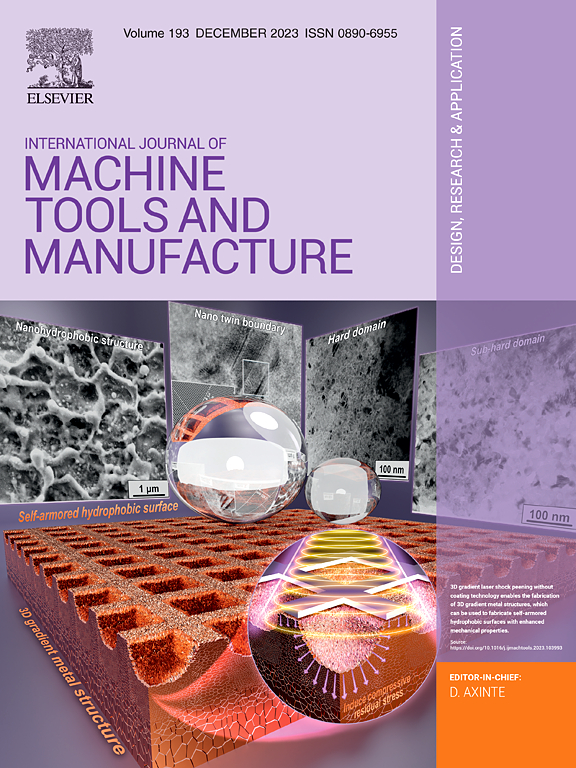Towards understanding the polishing behavior of thin anisotropic crystals: Coupling, discrepancy, and control across scales
IF 18.8
1区 工程技术
Q1 ENGINEERING, MANUFACTURING
International Journal of Machine Tools & Manufacture
Pub Date : 2025-04-01
DOI:10.1016/j.ijmachtools.2025.104269
引用次数: 0
Abstract
Thin anisotropic crystals (TACs) have potential applications in semiconductors, microelectronics, and aerospace. However, polishing a TAC workpiece with a compliant tool is highly challenging because of its susceptibility to deformation and brittle damage owing to its thin structure. Another significant challenge for polishing is the anisotropic discrepancy, which is highly dependent on the crystal planes/directions. To address these challenges and ultimately realize the process control of polishing a TAC workpiece, this study establishes a comprehensive multiscale modeling framework. The proposed framework analytically incorporates the macroscale tool–TAC interaction mechanics, macro/micro coupling material removal mechanism, and macro/micro coupling subsurface damage behavior according to the physical properties of a TAC workpiece. Experiments at different scales are conducted to validate notable discrepancies in the surface and subsurface material responses in the polishing of a TAC workpiece, agreeing well with analytical predictions. Based on the cross-scale study and framework, space- and time-domain control strategies are proposed, demonstrating the capability for effectively eliminating the anisotropic discrepancy from macro- to microscale and enabling deterministic control in the polishing of TACs.

了解各向异性晶体的抛光行为:耦合、差异和跨尺度控制
薄各向异性晶体(TACs)在半导体、微电子和航空航天领域具有潜在的应用前景。然而,由于TAC工件结构薄,容易变形和脆性损伤,因此使用柔性工具抛光TAC工件是非常有挑战性的。抛光的另一个重大挑战是各向异性差异,这高度依赖于晶体平面/方向。为了解决这些挑战并最终实现TAC工件抛光过程控制,本研究建立了一个全面的多尺度建模框架。该框架根据TAC工件的物理特性,将宏观尺度的刀具- TAC相互作用力学、宏/微耦合材料去除机制和宏/微耦合亚表面损伤行为进行了分析。在不同的尺度上进行了实验,以验证TAC工件抛光中表面和地下材料响应的显着差异,与分析预测一致。在跨尺度研究和框架的基础上,提出了空间和时域控制策略,证明了该策略能够有效消除宏观到微观尺度的各向异性差异,实现tac抛光过程的确定性控制。
本文章由计算机程序翻译,如有差异,请以英文原文为准。
求助全文
约1分钟内获得全文
求助全文
来源期刊
CiteScore
25.70
自引率
10.00%
发文量
66
审稿时长
18 days
期刊介绍:
The International Journal of Machine Tools and Manufacture is dedicated to advancing scientific comprehension of the fundamental mechanics involved in processes and machines utilized in the manufacturing of engineering components. While the primary focus is on metals, the journal also explores applications in composites, ceramics, and other structural or functional materials. The coverage includes a diverse range of topics:
- Essential mechanics of processes involving material removal, accretion, and deformation, encompassing solid, semi-solid, or particulate forms.
- Significant scientific advancements in existing or new processes and machines.
- In-depth characterization of workpiece materials (structure/surfaces) through advanced techniques (e.g., SEM, EDS, TEM, EBSD, AES, Raman spectroscopy) to unveil new phenomenological aspects governing manufacturing processes.
- Tool design, utilization, and comprehensive studies of failure mechanisms.
- Innovative concepts of machine tools, fixtures, and tool holders supported by modeling and demonstrations relevant to manufacturing processes within the journal's scope.
- Novel scientific contributions exploring interactions between the machine tool, control system, software design, and processes.
- Studies elucidating specific mechanisms governing niche processes (e.g., ultra-high precision, nano/atomic level manufacturing with either mechanical or non-mechanical "tools").
- Innovative approaches, underpinned by thorough scientific analysis, addressing emerging or breakthrough processes (e.g., bio-inspired manufacturing) and/or applications (e.g., ultra-high precision optics).

 求助内容:
求助内容: 应助结果提醒方式:
应助结果提醒方式:


